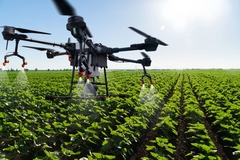Global microalgae market on upward curve as alternative protein companies shoot for price parity
02 Jun 2022 --- The microalgae market is expected to be worth US$1.8 billion by 2028 and record a compound growth rate (CAGR) of 10.3% for the same timeframe, according to forecasts. Driving this growth is the microalgae trend in health and wellness, dietary supplements, natural food colors, vegetarian products and nutraceuticals.
However, a challenge that needs to be overcome is making cost-effective solutions that compete with the likes of soy and pea protein, otherwise the space is at risk of remaining niche.
Competing with conventional pea and soy
Israeli-based microalgae protein company Brevel recently secured US$8.4 million in funding for its technology that combines sugar-based microalgae fermentation with a high concentration of light at industrial scales in a single process.

The result of this process is a protein that is anticipated to be price competitive with pea and soy, while being neutral in both color and flavor.
Microalgae is conventionally produced either by photosynthesis in outdoor or indoor ponds or closed reactors which are labor-intensive, suffer from contaminations and produce at low yields and high costs. Several microalgae species are coveted for their potential as value-added products with pharmacological qualities.
Several microalgae species are coveted for their potential as value-added products with pharmacological qualities.
Brevel’s alternative method is to use fermentation tanks where sugar is added to the process to allow the microalgae to grow at “significantly lower costs and higher yields”.
“Using light alongside sugar-based fermentation is a game-changer that provides us with a better positioning than other microalgae companies since most of the valuable fractions are only produced in light,” Yonatan Golan, CEO and co-founder, Brevel, tells FoodIngredientsFirst.
The process enables the production of microalgae at a cost reduction of more than 90% and includes nutrient-rich ingredients and functionalities produced in the presence of light.
Brevel’s protein comes as a dry powder that can be added directly to formulations. It can be added directly as a powder or apply some processes such as homogenization or secondary fermentation to increase its solubility and extract additional flavors.
“In the second stage, we will be looking to provide functionalities such as gelation, texturing, emulsification and more, which are most suitable for fish and seafood alternatives,” Golan adds.
Meatless charcuterie
Food biotech company NewFish is another company using fermentation processes. It ferments New Zealand microalgae and underused seafood to create new meat-free charcuterie. The company has developed two first-of-their-kind products to date, a Pāua Saucisson and a microalgae-derived Ocean Mortadella, both developed by Vaughan Mabee of Amisfield.
“The regeneration of our food and marine systems are at the heart of NewFish. We are reimagining seafood and human nutrition to replenish our oceans,” says Hamish Howard, general manager and co-founder, NewFish.
The company is undertaking multiple R&D streams to explore the unique nature of New Zealand pāua (abalone), microalgae and macroalgae (seaweed).
“We have an opportunity to build a cleaner, greener protein industry for Aotearoa, serving people across Asia Pacific and further afield. New Zealand is surrounded by water and we value the marine environment highly, so we should be known for our abundant, pristine oceans and the food they produce,” says Howard.
“At NewFish we are driving this change through novel nutrition solutions and ingredients that focus on the huge potential of both microalgae and seaweed,” he explains. A challenge that needs to be overcome is making cost-effective solutions from microalgae.
A challenge that needs to be overcome is making cost-effective solutions from microalgae.
Howard continues: “New Zealand is known internationally for its land products, when land is only 4% of who we are as a nation. We need to change the narrative so that we also become known for what comes from the other 96% of our country—its waters, and that’s what NewFish is doing,” he says.
Price parity of astaxanthin
Several microalgae species are being investigated for their potential as value-added products with pharmacological and biological qualities, according to a study by Microbial Cell Factories called, “The promising future of microalgae: current status, challenges, and optimization of a sustainable and renewable industry for biofuels, feed, and other products.”
Hawaiian-based biotech company Kuehnle AgroSystems (KAS), for example, aims to make a microalgae-based astaxanthin cost-competitive with the synthetic sources.
KAS has patented a novel fermentation technology and algae strain to produce natural astaxanthin at scale and at a fraction of the cost of current products. The company has engaged in research and development for the past six years.
Astaxanthin – a feed supplement that enhances pigmentation in species like salmon, rainbow trout, Arctic char and shrimp – is currently a staple ingredient in aquafeeds. Aquaculture is driving the demand for the antioxidant-rich carotenoid, accounting for 47% of the US$1.37 million global market.
Currently, 95% of available aquafeeds are made with synthetic astaxanthin but the demand for natural astaxanthin is growing due to growing demand for organically farmed fish and interest in more sustainable production.
Regional market analysis
According to the “Microalgae Market by Distribution Channel, Type, Application - Global Forecast to 2028,” compiled in collaboration with the European Algae Biomass Association (EABA), the five major geographies for microalgae are North America, Europe, Asia-Pacific, Latin America, and the Middle East & Africa.
North America is estimated to account for the largest share of the global microalgae market in 2021, followed by Asia-Pacific and Europe.
Europe is expected to witness significant growth during the forecast period, mainly due to the increased adoption of microalgae, especially spirulina and chlorella, in the manufacturing of therapeutic & nutritional products, growing reluctance toward the usage of synthetic colors, rising demand for natural blue colorants, and investments from leading color stakeholders in the phycocyanin space. Natural food color is one trend driving the growth of microalgae use.
Natural food color is one trend driving the growth of microalgae use.
GNT, for example, has expanded its range of EU organic-certified Exberry Coloring Foods with new yellow and green shades made from organic safflower and spirulina.
Microalgae innovation pipeline
Researchers have developed high-protein microalgae strains with improved taste, upscaled by Allmicroalgae as part of the EU-funded project ProFuture, which is positioning its microalgae ingredients as aiding the shift to more plant-based diets within the Farm to Fork Strategy. A Chlorella strain could be used in vegan sausages, snacks, soups and vegetable creams, sports drinks, bread and pasta, all with improved nutritional quality and desirable sensory properties.
In addition, the Portuguese provider Allmicroalgae manufactured two Chlorella vulgaris microalgae powders that have been approved as food ingredients and food supplements by the European Food Safety Authority (EFSA). The variants White and Yellow Chlorella vulgaris are noted for their sensory profile. Compared to conventional, intensely green-colored products, these latest offerings are more visually neutral and deliver a discrete taste profile.
Meanwhile, Israeli marine ingredient start-up Yemoja unveiled its red microalgae “Ounje” to infuse bloody juiciness to plant-based burgers and steaks for an authentic medium-rare experience. The formulation mimics the red juices of meat. Most products in this space are currently using beetroot juice and color additives.
Singapore-based Sophie’s Bionutrients, a sustainable urban food production technology company, entered the global 2020 FoodTech 500 rankings, listing top agrifood tech start-ups and scale-ups.
By Inga de Jong













